Garden Faerie: Ant plants debut at Matthaei Botanical Gardens
One of the things I like most about gardening is that you never know what cool new thing you'll discover next. Last week, while volunteering with Project Grow in the Matthaei Botanical Gardens greenhouses, I noticed some of the cutest seedlings I'd ever seen. And so, kind of like Alice falling down the rabbit hole, I stumbled into the fascinating world of ant plants.
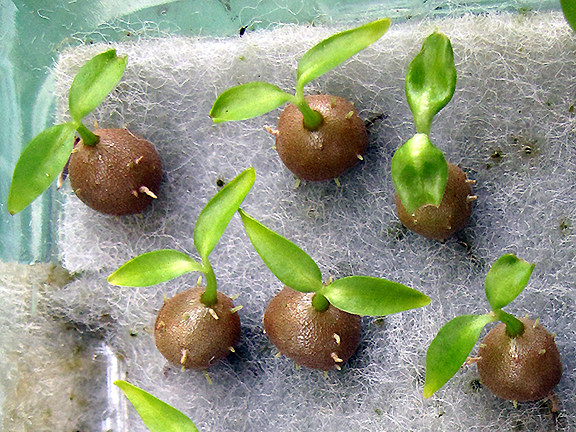
Ant plant seedlings develop the caudex (the bulbous area where the ants will live) as early as the first few days after germination. These seedlings just grew their first set of leaves and roots.
Monica Milla | Contributor
I happened to be in the greenhouse the same time as local ant plant expert Frank Omilian, who recently donated a collection of ant plants and ant ferns†to Matthaei. Several of his plants are on display in the Matthaei's tropical conservatory, while he is growing others in the greenhouse.

Frank Omilian's donated ant plants are thriving in the Matthaei greenhouse.
Monica Milla | Contributor
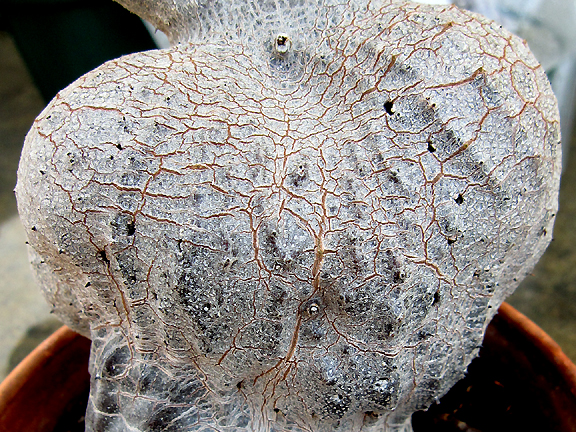
Entry holes for the ants form as the plant caudex matures.
Monica Milla | Cotributor
The caudex forms two types of chambers: one with smooth walls and one with "warts" that help the plant absorb nutrients.‡ The ants raise larvae and pupa in the smooth chambers and deposit waste in the warted chambers. As the waste decays, it releases nutrients such as nitrogen, phosphorus, and potassium, which help the plant to grow.
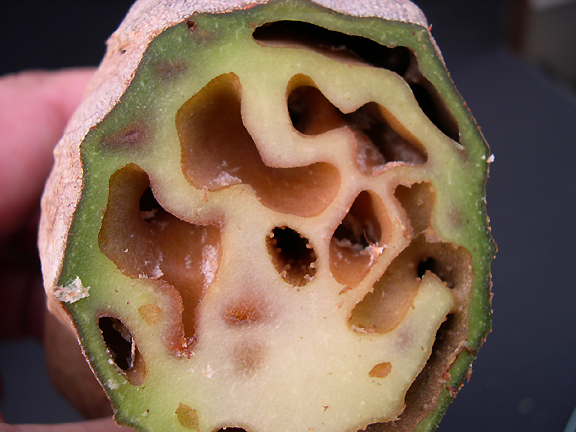
Cross-section of a 2.5-inch diameter caudex of Myrmecodia tuberosa. The smooth chambers are where ants raise their young; the "warted" chambers are "restrooms."
Photo by Frank Omilian, all rights reserved
Ant plants (Hydnophytum and Myrmecodia species, anyway) produce tiny (three- to 16-milimeter) tubular flowers, usually in white. They are self-pollinating, as the ants often chase away pollinators as well as predators. The flowers turn into small orange or red fruits that birds like to eat.
Another cool adaptation is how the plant ensures its seeds get stuck on trees, instead of falling to the ground where they wouldn't grow (as their roots need air to sprout). The seed is protected by a hard coating (an endocarp), which in turn is enclosed in a sticky strand of fruit flesh. This sticky strand often adheres to birds' beaks as they eat the fruit, and they then rub it off on the bark or branches of trees, where the seed can then settle and grow.
How cool is that? Seriously.
Ant plants grow naturally in tropical Southeast Asia. Most ant plants are epiphytes, living on the surface of other plants such as trees. Epiphytes have aerial (above-ground) roots that attach to the host plant, and which would rot in soil. The roots grab onto the bark of the tree and sometimes encircle the entire trunk. Ant plants, like other epiphytes, often grow higher up on trees in the forest, where they have better access to sunlight. They also prefer trees with spongy bark that absorbs rain water which also feeds their roots.
These kinds of trees are not always available in conservatories, so you will see a little wire helping hold some of the ant plants to trees in the Matthaei conservatory. Omilian is growing other ant plants in the greenhouse in pots using a soilless mix of bark, long-fiber sphagnum, perlite, charcoal pieces and coconut husk chunks. (This mix is similar to what orchid growers use.)
The ant plants currently on display (though you'll have to look hard to find them, kind of like playing Where's Waldo) in the tropical conservatory at Matthaei Botanical Gardens are shown in the following four photos:
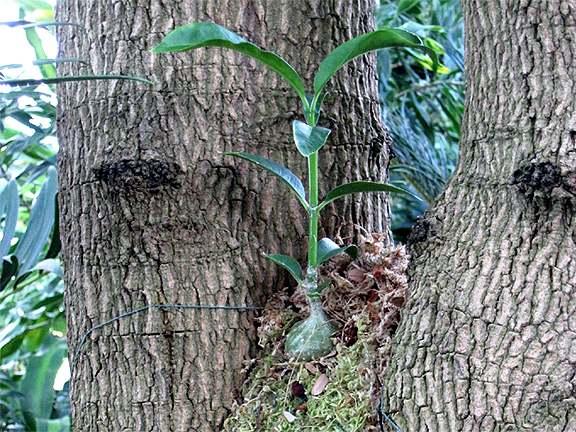
One-and-a-half-year-old seedling Hydnophytum simplex on a tamarind tree.
Monica Milla | Contributor
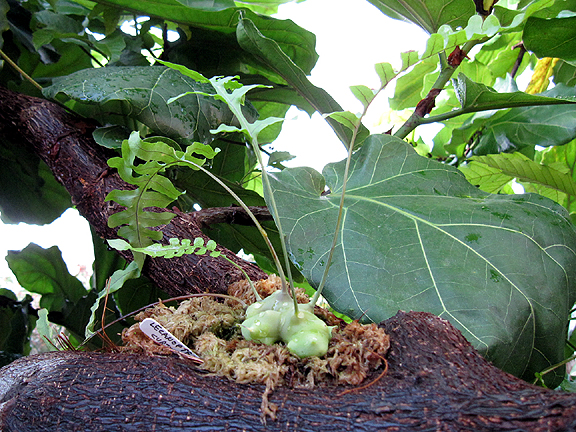
Lecanopteris curtisii (ant fern) on the fiddle-leaf ficus tree
Monica Milla | Contributor
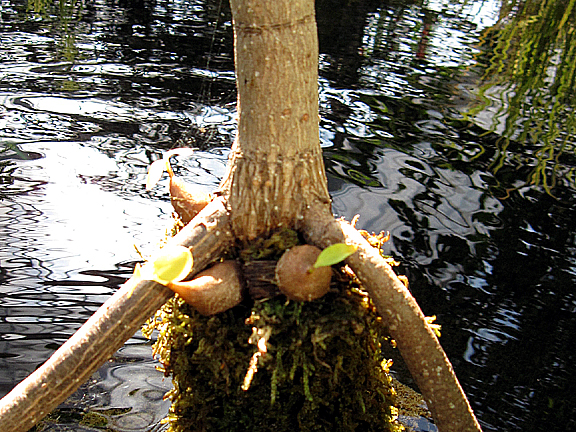
Two small seedlings of Myrmecodia tuberosa and one small Hydnophytum formicarum on the mangrove (in the pond near the conservatory entrance)
Monica Milla | Contributor
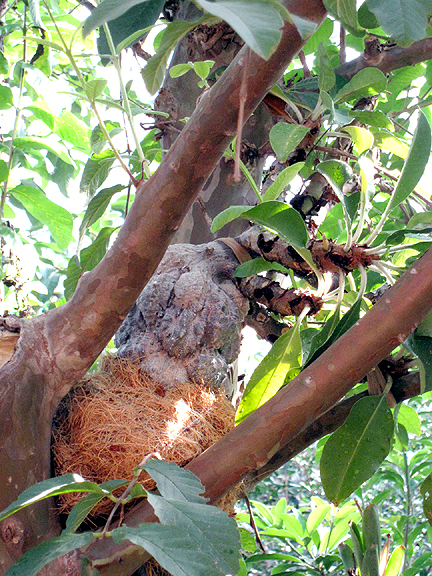
A large, mature Myrmecodia tuberosa on the guava tree. This one houses a colony of tiny ants!
Monica Milla | Contributor
Many thanks to Frank Omilian for speaking with me, patiently answering questions and sending me wonderful reference materials.
This post is part of Epiphyte Day, sponsored each month by The Rainforest Garden.
†Most ant plants are in the genus Myrmecodia or Hydnophytum. There are also ant ferns in the genus Lecanopteris. In this article, l refer to both families as "ant plants."
‡ Ant ferns do not have warts in the chambers, but they still absorb nutrients.
Monica Milla, the Garden Faerie, is a master gardener volunteer, instructor, speaker, garden coach, and author of "Fun with Winter Seed Sowing."


Comments
ssgardengirl
Tue, Mar 15, 2011 : 6:21 p.m.
They are so cool! I'd never heard of, or seen an ant plant until seeing you at the garden show.
Neal Foster
Fri, Mar 4, 2011 : 2:21 p.m.
Monica - Matthaei also has several live specimens of orchids of the genus Myrmecophila (nowadays usually placed in the genus Schomburgkia) which--as described in Wikipedia--"are either epiphytic or lithophytic in their growth habit. Their slightly scented flowers are produced on pole like growths that extend upwards from 1 to 4 meters high and take up to 4 months to develop. Several of the Schomburgkia species were transferred into the genus Myrmecophila by Robert Allen Rolfe in 1917. The name Myrmecophila is a derivative of the word myrmecophile and refers to the symbiotic relationship with colonies of ants that are usually found living in the large, hollowed-out, banana-like pseudobulbs. An opening in the base of each pseudobulb serves as an entrance for the ants which harvest nectar from the peduncles and flowers and forage on other plants in the community. The ants associated with Myrmecophila tibicinis pack many of the pseudobulbs with debris that includes other dead ants, a variety of insects, pieces of plant material, seeds and sand."
t
Thu, Mar 3, 2011 : 6:55 p.m.
Thanks for highlighting MBGNA and our great volunteer, Frank Omilian. Tara Griffith, MBGNA Volunteer Coordinator
Monica Milla
Thu, Mar 3, 2011 : 2:57 a.m.
Ramon, I can't tell you how cool I find them! Oh, wait. Yes I can, and in fact just did. :) Next time I'm at LPC, I'll have a shufty. Amy, There are apparently three more ant plants in the fiddle-leaf ficus--look for them! :)
Amy Bruhn
Wed, Mar 2, 2011 : 10:08 p.m.
Those plants are so cool! I don't think I ever heard of them before. Thanks for the pictures and the plant locations - now I'll have to make a trek out to Matthaei and go on a scavenger hunt to find them.
Ramon
Wed, Mar 2, 2011 : 8:05 p.m.
I love ant plants! I've only seen one before at the Lincoln Park Conservatory in Chicago, IL. But I'd never seen a cross section of what it looked like inside. Great post!